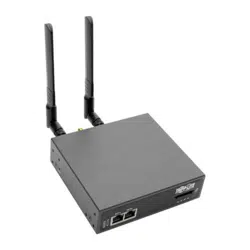Loading ...
Loading ...
Loading ...

96
5. Firewall, Failover and OOB Access
The DHCP server also supports pre-assigning IP addresses to be allocated only to specific MAC addresses and reserving IP
addresses to be used by connected hosts with fixed IP addresses.
Once applied, devices on the internal network will be able to access resources on the external network.
5.8.3 Port / Protocol Forwarding
When using IP masquerading, devices on the external network cannot initiate connections to devices on the internal network.
To work around this, port forwarding can be set up to allow external users to connect to a specific port or range of ports on
the external interface of the console server/cellular router. The console server/cellular router redirects the data to a specified
internal address and port range.
To set up a port/protocol forward:
• Navigate to the System: Firewall page and click on the Port Forwarding tab.
• Click Add New Port Forward.
• Fill in the following fields:
Name: Name for the port forward. This should describe the target and the service that the
port forward is used to access.
Input Interface: This allows the user to only forward the port from a specific interface. In most
cases, this should be left as “Any”.
Source Address/Address Range: This allows the user to restrict access to a port forward to a specific source IP
address or IP address range of the data. This may be left blank. IP address ranges
use the format ip/netmask (where netmask is in bits 1-32).
Destination Address/Address Range: The destination IP address/address range to match. This may be left blank. IP
address ranges use the format ip/netmask (where netmask is in bits 1-32).
Input Port Range: The range of ports to forward to the destination IP. These will be the port(s)
specified when accessing the port forward. These ports do not need to be the same
as the output port range.
Protocol: The protocol of the data being forwarded. The options are TCP or UDP, TCP and
UDP, ICMP, ESP, GRE and Any.
Output Address: The target of the port forward. This is an address on the internal network where
packets sent to the Input Interface on the input port range are sent.
Output Port Range: The port or range of ports that the packets will be redirected to on the Output
Address. Ranges use the format start-finish. This option is only valid for TCP and
UDP protocols.
Loading ...
Loading ...
Loading ...
